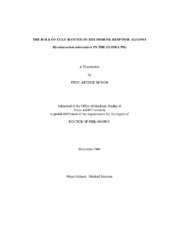| dc.description.abstract | Tuberculosis is the second leading cause of morbidity and mortality worldwide due to an infectious disease. Development of a new tuberculosis (TB) vaccine would be facilitated by a better understanding of the mechanisms of protection induced by the current TB vaccine, Mycobacterium bovis BCG. Recombinant guinea pig (rgp)CCL5 and anti-rgpCCL5 were developed and characterized. The biological activity of rgpCCL5 was determined in a chemotaxis assay using T lymphocytes and pleural exudate cells. The specificity of rabbit anti-rgpCCL5 polyclonal antibody was confirmed by Western blot. RgpCCL5 was used to stimulate alveolar and peritoneal macrophages in vitro. and cytokine/chemokine gene expression was evaluated using real-time PCR. RgpCCL5 stimulated TNFα, IL-1β, CCL2, and CXCL8 mRNA
expression and TNFα protein production (as assessed in the L929 cell bioassay) in macrophages. The effect of BCG-vaccination on CCL5 expression and production in leukocytes infected with M. tuberculosis was examined in vitro and in vivo. Polyclonal anti-rgpCCL5 was used to develop an ELISA assay to quantify gpCCL5 protein levels, and real-time PCR was used to detect CCL5 mRNA. Leukocytes isolated from BCG-vaccinated guinea pigs and infected in vitro with virulent M. tuberculosis demonstrated significantly elevated gpCCL5 mRNA and protein compared to cells from naive animals. The response of gpCCL5 to M. tuberculosis in vivo was studied in tuberculous pleural effusions, where peak levels of CCL5 mRNA and protein were reached at day 4 post-induction. Disease severity, cellular differentiation, histology, and cytokine/chemokine mRNA levels in pleural cells and granulomas were analyzed on day 4 in guinea pigs induced with tuberculous pleurisy and treated with either rgpCCL5 or anti-rgpCCL5 by direct intra-pleural injection. In these studies, neutralizing CCL5 resulted in reduced macrophage accumulation, diminished levels of IFNγ, TNFα, and CCL5 mRNA in pleural effusion cells, and reduced spontaneous lymphocyte proliferation. Together these studies suggest an important role for gpCCL5 in activating leukocytes during M. tuberculosis infection. | en |


